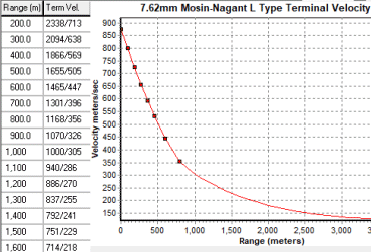|
WWII Ostfront Bullet Ballistics |
||


|
Panzer War doesn't need an analysis of bullet ballistics for an infantry vs. infantry fight. Only the abstract killpower is ever used. The ballistics might be used in machinegun vs. armor contest but that is fairly limited. |
||

|
I found only one ballistics firing table for the Russian Mosin-Nagant. This has a number of different bullet choices. The one that best matches data from a 1947 pamphlet that included a Marksman chart is the M91 Finnish bullet. We can't assume the Soviets were using Finnish ammunition during WWII. However, this is in 1947 chart so Soviet quality could have improved. |
||

|
The ballistics does match the time-of-flight of the chart for each range except at 100 meters. At the same time the M91 Russian bullet has the same ballistic coefficient. So this may be a computer generated table. |
||


|
Generated firing table and ballistic chart of K98k fired 7.92 x 57 s.S. Patrone 197.5 grain heavy ball round (760 m/s, B.C G1=0.576). |
||
|
Generated firing table and ballistic chart of Mosin-Nagant fired 7.62 x 54 148 grain Type L light ball round (865-870 m/s, B.C. G1=0.363). |
||
|
Mosin-Nagant accuracy. According to the Marksman site the group spread at 800 meters was a width of 52cm and height spread of 65 cm. This is equivalent to 65 x 81.25 at 1000m. However, this is a 70% zone. To convert a 70% z to a 50% z we have to divide by 1.55. Thus our 50% zone would be 0.419 x 0.5226m @ 1000. |
||

|
Generated firing table and ballistic chart of Mosin-Nagant fired 7.62 x 54 185 grain Type D heavy ball round (800 m/s, B.C. G7=0.246). |
||




